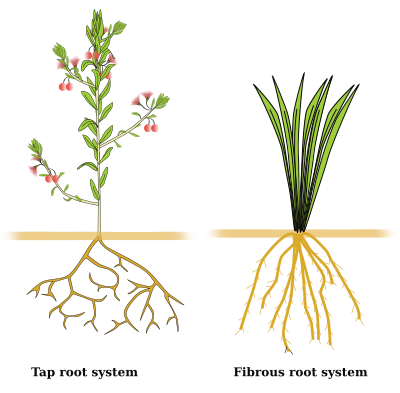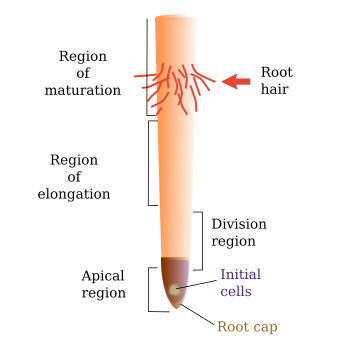1. Introduction
The root is the bottom part of the plant body axis. It is usually under the ground, although there are some aerial and aquatic roots. The total roots of a plant is known as the root system. The main functions of roots are to anchor the plant to the ground and absorb water and minerals. Roots may perform other functions: storage, hormone synthesis, aeration in aquatic plants, and as an organ for plant propagation. Roots are associated with some types of fungi to form mycorrhizae, and others, such as leguminous roots, with some symbiotic bacteria to form nodules. These mutualistic associations greatly improve the absorption of nitrogenous substances by roots.
All vascular plants can grow true roots, although they are not formed in some primitive and some epiphyte plants. Some non-vascular plants, like mosses and hepatic plants, show underground structures called ryzhoids that anchor the plant body to the ground and absorb water, but they lack vascular bundles. True roots always have vascular bundles containing xylem and phloem.
2. Organization
The root is the first structure that sprouts out of the embryo in the seed. This initial root is known as the radicle. The morphology of the root system depends on the plant type. The root system may form from a main root derived from the radicle that branches many times, giving lateral roots (Figure 1). This root disposition is typical of gymnosperms and dicotyledons, and it is known as tap root system. The primary root is viable during the plant life span and it usually get very deep in the ground.

In many monocotyledon species, the primary root is later substituted by many roots emerging from the stem or leaves. All these roots have more or less the same size and length and form a root system known as fibrous roots (Figure 1). They don't get deep in the soil, but they provide good anchorage for the plant body. That is why species with fibrous roots are suitable to prevent soil from being lost by erosion.
Roots emerging in the adult plant from the stem, leaves, or roots (differently from the lateral roots of axonomorph root systems) are known as adventitious roots. Some plants can propagate through stolons, including strawberries, African violets, or shoots like blackberries.
3. Regions
From the tip to the more mature parts, several regions can be distinguished in roots (Figure 2). Although these regions are observed in most roots, they may show different lengths according to the species and environmental variables.

Apical region. The apical root meristem is found in the apical zone, covered by a protective layer known as the root cap, or calyptra. A group of initial cells (undifferentiated cells) are found in the apical root meristem that give rise to every cell type in the root. Initial cells show a low division rate. Near the initial cells, the procambium, grown meristem, and protodermis are meristems that differentiate into vascular bundles, cortex and epidermis, respectively. The initial cell surrounds the quiescent center, a group of cells that seems to control the behavior of the initial cells. Besides protecting root meristems, the root cap releases mucilaginous substances and dead cells that become lubricants for facilitating the growth and preventing mechanical friction of growing roots.
In the central zone of the root cap, there are two columns of cells, collectively known as columnella. There is a gravity sensor in some columnella cells that allows the root to grow to the center of the earth. It is the positive gravitropism of roots, which is teporarely absent in lateral branches or does no exist at all.
The cell division zone starts after the initial cells. Here, cells divide quite frequently to increase the total number of cells and form all the root tissues.
The elongation zone region of a few millimeters in length where cells increase in size. Roots may grow in length through this cell elongation as well as by the addition of new cells in more apical zones.
In the maturation zone, cells begin to differentiate and get specific cellular features to be functional in each tissue that forms the mature root. Root hairs differentiate from epidermal cells in this region.
The borders between these regions are not clearly defined. For example, cells that become vascular bundles start the differentiation process in the elongation region. In addition, the regions are moving together with the apical root tip during root growth.
Roots may show primary and secondary growth. Primary growth is largely involved in the root length increase, whereas secondary growth leads to a larger diameter. The type of growth and the group of plants (monocot and dicot) are the features we are going to consider when studying the microscopic anatomy. Because roots lack nodes and internodes, the general anatomy is quite similar along the root extension.
4. Functions
Anchoring is an important function performed by roots that is often taken for granted. However, it is essential for plant survival because it keeps plants erect and allows them to withstand adverse environmental. Water and mineral absortion is another essential function of roots. In some species, a large part of the water and minerals absorption is done by the fungi hyphae (mycorrhizae) associated with roots. Anyway, roots are responible for searching water resources by growing through the ground. This search process makes roots outstanding ground transformers. Some roots are specialized in less typical functions such as gas exchange, storage, there are contractile roots, and so on.
-
Bibliography ↷
-
Joshi M, Ginzberg I. 2020. Adventitious root formation in crops—Potato as an example. Physiologia Plantarum. 2020:1-10. DOI: 10.1111/ppl.13305.
Rellán-Álvarez R, Lobet G, Dinneny JR. 2016. Environmental control of root system biology. Annual review of plant biology. 67: 20.1-20.4. DOI: 10.1146/annurev-arplant-043015-111848.
Rost TL. 2011. The organization of roots of dycotiledonous plants and the positions of control points. Annals of botany. 107: 1213-1222. doi: 10.1093/aob/mcq229.
-